The ever enjoyable combination of reading, thinking, talking and writing has become a full-time occupation. Follow the link below to find out more about what I’m doing now, as a doctoral candidate at Queen’s University Belfast, Northern Ireland.
It’s gone relatively quiet here, because I’m now involved in other projects. You can watch our progress over at the Studio 9 wiki.
The pdf copy of the The Comic Architect has now been uploaded to the University of Sheffield School of Architecture’s digital archive. You can access the digital archive from any university computer, or further afield if you have a Sheffield username and password.
Or you can click through to the digital archive from the departmental website:
This blog has now reached a turning point. It was created last spring to record the processes that I went through as part of my Masters in Architecture dissertation. This week, the final text has been printed and bound, and is now with the staff at the University of Sheffield for marking. The project is, for now, completed.
As my supervisor suggested yesterday as I started rambling about other projects I’m interested in exploring, it’s time to take a break from research. I have the rest of the academic year’s design courses to concentrate on, first with the ongoing Live Project and then with the studio that will keep me occupied until next summer.
But this blog is going to continue. Nothing exists in a vacuum, so although the material that I’ll be posting here will probably begin to move away from comics, it will remain within the field of architecture and act as an ongoing journal of my own personal thoughts and readings related to my research and theoretical study. There are a number of interesting avenues that I want to explore, and the blog will be a place to test out ideas and open them to a wider audience. It would be foolish to forget about the head of steam that this page has built up, and I sincerely hope that there will continue to be something here for you to read and respond to.
So, watch this space… there’s so much more to come.
Here is the complete text of The Comic Architect: words and pictures along the line between architecture and comics – the M.Arch dissertation that this project has produced.
It includes in the appendices the three interviews I conducted with Joost Swarte, Henk Döll and Ben Katchor.
Please note that in uploading this dissertation, I am concious that the text includes illustrations of drawings, paintings, comics and prints made by other artists. These were used in the dissertation for illustration purposes, and in the context of the submission could be included without permission being sought. Now that I am, in effect, publishing this dissertation, I am aware we are approaching a copyright issue. To this end please note that all work remains that of the original artist. If you represent someone who I have cited, or if your work is included and you are not happy to see it in this context, please contact me as soon as possible and I will respect your requests.
The text itself and the interviews are published here under a Creative Commons licence. Please contact me if you would like to reproduce any part of it.
After almost nine months, the dissertation is done. I put the finishing touches to the 10,000 word text (and the 22,000 word appendices, which included the three interviews with Joost Swarte, Henk Döll and Ben Katchor) on Wednesday night, before taking two copies to be bound. One is being lovingly stitched into a deep red hardback cover by Sue Callaghan on Division Street in Sheffield, while the other is getting a much more mundane black plastic cover for the University of Sheffield Library. Both copies go in for marking on Tuesday.
A special foreward went into the dissertation explaining the role of this blog, and the project’s online presence. This is the first time that I’ve put so much energy into using the internet for recording my work, and I’m now very interested in following and developing the use of blogs in the academic world. As we speak, I’m involved in a live project which has its own blog and which has had almost 700 hits in less than two weeks. Blogs are perfect for solo or group projects which require some public face to discuss what’s going on and to solicit comments or opinions for participants, stakeholders or anyone who happens to be interested. My misfortune with bag handlers at Philadelphia Airport also means that I’ve appreciated the blog as a way of backing up the work, preserving the vital processes that lead to a finished academic text.
I’ll be uploading a compressed pdf of the dissertation itself in the next couple of days. A similar pdf will be added to the University of Sheffield School of Architecture’s digital archive.
Thanks for the continued support and interest of everyone who’s been following the project, and keep an eye on this blog as it develops with my own personal research projects.
This blog post was started months ago but was abandoned due to other commitments. It is, however, a relevant account of one article that was particularly important to the dissertation.
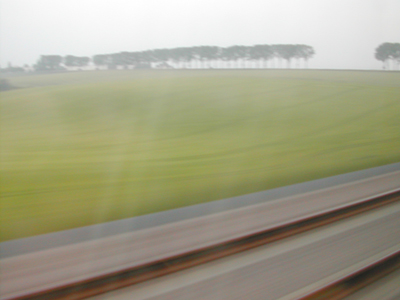
Welcome back to those loyal regular readers who have missed me for almost a month. My apologies for the prolonged silence, but with the end of the academic term in France I’ve been somewhat occupied submitting design projects and relocating back to the UK. I’m now settled for the summer in sunny London, looking forward to the convenience of the the capital’s various libraries and galleries. It’s been several weeks since I started reading Nathalie op de Beeck’s 2006 essay Found Objects, published in volume 52, number 4 (winter 2006) of MFS Modern Fiction Studies. The article is available online for most academic institutions via the Muse portal.
With just a few weeks left of my semester here in Strasbourg, there was time for one last weekend trip before the final push towards the end of term. So on a warm Thursday evening I was at Strasbourg station to board train 64 to Paris: a ‘proper’ train of sparkling white and red German Railways carriages en route from Munich to Paris. This elegant old train arrived with a full service restaurant car and a rake of first and second class carriages, each offering big open saloons or more private six seat compartments. Why the importance of this train? Because this would be one of the last days that train 64 would operate. Just three days later, Strasbourg was to be catapulted into the twenty-first century with the arrival of the TGV Est Européen. Every one of the old fashioned trains will be replaced by modern high speed trains. The restaurant cars are going, the old passenger compartments are disappearing, and fares are being cranked up – on average by about 30-35%. Even the once-mythical Orient Express – which once connected London with Istanbul – is getting another leg chopped off its once grand route: from this weekend it will only operate between Strasbourg and Vienna, barely an overnight shuttle.
With a lingering nostalgia for a soon-to-be-antiquated form of transport, I found my reserved seat in a compartment. As we left Strasbourg, I considered that this was the ideal situation for me to catch up on some reading – on a leisurely four hour train ride through rolling countryside. And as we passed through Lorraine, I splashed out on dinner in the restaurant car, and drank to the death of ‘real’ train travel. An atmosphere of lingering nostalgia was suitably established.
op de Beeck introduces her essay by explaining how she sees Jem Cohen’s film Lost Book Found and Ben Katchor’s comic strip Julius Knipl Real Estate Photographer through the “contemporary interpretations [ … that … ] relfexively intersect with Walter Benjamin’s critical theory.” (p. 808). Cohen and Katchor “critique contemporary existence by remaining closely observant to overlooked details, outmoded artifacts, memory and forgetting … they attend to the passage of time, the gradual obsalence of machines and functions, and entropic repitition in the urban space” (p. 808). op de Beeck classifies Katchor’s comic strips and Cohen’s films as aphoristic formats: “we read it fast, but the melancholic sensation lingers” (p.808). Similar, perhaps, to the effect of a train journey. Reminiscent also of Larkin’s Whitsun Weddings, and the cricket player seen from a moving train, running up to the stumps but out of sight by the time he bowls.
The essay has introduced me to a filmaker (Cohen) and a film that I did not previously know of (Lost Book Found). In Lost Book Found a wandering narrative is told by a pushcart vendor in New York City, who encounters a lone man fishing for detritus through street sewer grilles. The pushcart vendor is an invisible observer in the bustling city – an anonymous figure who becomes so recognisable that he is quickly overlooked and made part of the cityscape. Similarly, the real estate photographer Julius Knipl explores Ben Katchor’s re-imagined New York City as a near-invisible observer.
Their texts overlap in mutual appreciation of transience, futile gestures, and the human condition … both Katchor and Cohen contribute to a dialogue on the remembered past, with a critical eye on how antique artifacts and productive labor are understood…
Nathalie op de Beeck, Found Objects, MFS vol. 52 no. 4, Winter 2006
As an architect, I am interested in the narrative techniques of urban observers such as the pushcart vendor and Julius Knipl: participants in a complex urban geography who, because of their profession or social situation, become extremely well placed observers and even chroniclers of the passage of time in a city. The idea of adopting the role of such a person in order to re-map urban spaces is nothing new in more progressive schools of of architecture, but it also presents many exciting opportunities to consider the understanding and broader presentation of architectural environments as they are occupied and changed over time.
Katchor promts readers to recognize the significance of each tiny detail, and in that brief wakefulness, to sense the overwhelming intricacy of modern life.
Nathalie op de Beeck, Found Objects, MFS vol. 52 no. 4, Winter 2006
Cohen asserts his camera’s eye through the use of documentary-style cinematic techniques. Katchor, meanwhile, draws a complete fiction of a city with such attention to detail, and such a furtive and fast moving line that we are drawn into imagined but utterly convincing urban environments.
This false work of so-called memorializing – creating imaginary places, fake memorials to sympathetic people, and auratic objects analogous to actual artifacts – becomes crucial to storytelling, and to the cultivation of contemporary empathy despite mass distraction.
Nathalie op de Beeck, Found Objects, MFS vol. 52 no. 4, Winter 2006
Just like Garrison Keillor’s Tales from Lake Wobegon or Stuart McLean’s stories from the Vinyl Café, fictional environments and settings are vital to convincing storytelling. I extremely interested in Katchor’s tales of the city precisely becaue they invoke such powerful sensations of nostalgia and loneliness, even though they are set in places that never existed.
For your information, from the Alternative Architectural Praxis blog…
Alternate Currents is a major international symposium which looks at alternative forms of architectural praxis. The symposium will present a range of ideas from around the world which propose new and reflective ways to conduct architectural practice. Many of the speakers start from a critical position with regard to the normative models of architectural practice and the values embedded in it. Whether from political, social, gender or theoretical standpoints, the speakers propose innovative ways of thinking about the future of architectural practice. The symposium is open to all and is particularly relevant to practitioners and students interested in alternative ways of operating.
The symposium will be held in Sheffield and runs from 10.00am on 26th November to 5.30pm on 27th November. There is no charge, but it will be necessary to register for the event. The symposium is part of an AHRC funded research project, Alternative Architectural Praxis, being conducted at the School of Architecture, University of Sheffield by Jeremy Till and Tatjana Schneider.
Speakers
_Tessa Baird, Anna Holder, James Wakeford / London
_Jens Brandt / Copenhagen
_Carolyn Butterworth + Sam Vardy / Sheffield
_Jonathan Charley / Glasgow
_Prue Chiles + Leo Care, BDR / Sheffield
_Pedro Gadanho / Lisbon
_Emiliano Gandolfi / Rotterdam
_Mathias Heyden / Berlin
_Andreas Lang, public works / London
_Maria Lucia Malard / Belo Horizonte
_Ruth Morrow / Belfast
_Andreas Müller / Berlin
_Constantin Petcu, Doina Petrescu + Helen Stratford / Paris/Cambridge
_Jean-François Prost / Montreal
_Colin Ripley / Toronto
_Flora Samuel / Bath
_William Tozer / LondonKeynote
_MOM/ Belo Horizonte/Brazil
Apologies for not posting anything for a while; the project is progressing rapidly, and the final text will be submitted in just over two weeks time. I enjoyed an interesting conversation with Ben Katchor in New York City a few weeks ago, and after some time and space to think about the project (while piloting a white Mustang convertible around the American mid-west) it’s now time to get my head down and finish writing the damn thing.
I’ll bring you more news of the hard slog in the coming days. I’m now back in Sheffield and starting my courses here for the sixth and final year of my architectural education. It’s good to be back, but after all this time, the freshers look even younger than ever. I must be becoming part of the furniture.

Time for some healthy cross-promotion of one of my other online personas. The handy digital recording equipment that I’ve been using for my interviews during this project has also allowed me to launch into another creative sphere – podcasting. I’ve been blogging personally for a couple of years now, and with this and other blogs, have begun to experiment with the medium for academic projects as well.
As way of practising and exploring the podcast format, I’ve been producing an occasional podcast for a couple of months now, which is promoted through the iTunes store and my personal blog ontheroad. While the majority of my interviews with Henk Döll and Joost Swarte are remaining offline for now, episode five of the ontheroad podcast is a more or less unedited audio walk through Joost Swarte’s home town of Haarlem, near Amsterdam in the Netherlands. It was recorded after I had interviewed him, when he suggested we go for a meander through the bustling market town to see the theatre that he designed with Henk Döll, and a more recent social housing project on an adjacent site. Follow the links above to download the episode or (better still) subscribe to the podcast so that you get every episode as soon as it’s released.
I don’t believe that the omens are good for my career as an interviewer. As you may know by now, I was involved in a car crash en route to interview Joost Swarte and Henk Döll in the Netherlands. While I haven’t been involved in any road traffic accidents getting here, to New York City where I’ll be interviewing Ben Katchor later this week, I have lost all my luggage. My one piece of checked baggage disappeared somewhere in Philadelphia International Airport, never to be seen again. Unfortunately all my research notes and dissertation papers were inside my bag, as well as two well thumbed copies of Katchor’s books Julius Knipl Real Estate Photographer.
On the one hand, this is extremely frustrating, not least because I’ve now been wearing the same clothes for 48 hours, and it’s extremely hot and humid here in Manhattan. On the other hand, it’s a worthwhile vindication of this blog, which has acted as a digital backup of virtually all my work up to this point. If the hit counter starts to spin in the coming weeks, it’s probably not because the blog is becoming more popular, simply that I am using it more in my own research to retrace my steps through my research.
I’m hoping to meet Ben Katchor towards the end of this week. Part of the interview might appear as a forthcoming podcast, and excerpts will also emerge here in due course.

With the end of year shows in Britain’s architecture schools all now done and dusted, I was a little late coming across an article in the architects’ weekly newspaper BD (10 August 2007) entitled A Sense of Adventure (registration required). The feature examined a number of projects from the cream of this year’s graduating diploma students in architecture. One project that caught my eye in particular was a house of sorts by Dundee School of Architecture graduate Paul Maich.
This project for “cognitive dwelling” is framed by an elaborate quasi-autobiographical narrative. Paul Maich establishes five characters — the insomniac, the inventor, the miner, the amnesiac and the recluse — each of which corresponds to an aspect of his own character.
The cognitive dwelling itself is a freestanding brick volume laced by a labyrinthine sequence of passageways which seeks to embody these different character traits.
“This is essentially my own existential Soane Museum,” says Maich. “It is an architectural personification of character. The design exercise questions whether existence and experience can be transposed into architectural form; a personified architecture.”
Within the narrative, Maich is murdered in his own building by one of the five characters and a police investigation ensues, deftly illustrated by a storyboard-like arrangement of scenes.
“This is a project that illustrates the ambiguities between architecture and art,” said Jeremy Dixon.
“It would sit very happily in an art gallery both as a piece of sculpture and a thoroughly sinister narrative. The graphics pull out the dark elements of the story very dramatically and sit alongside the enigmatic brick object in a way that stays in the memory.”
The article teases us with a few frames from the sequential narrative of the final project presentation. The use of extremely tightly rendered architectural images with superimposed comic-book-style narration doesn’t feel quite right. Perhaps it’s because the faux-hand-written typeface of the narrative boxes doesn’t do the rest of the frame justice, I’m still not quite sure, and would prefer to reserve judgement until I’d seen the whole thing. But the whole project oozes richness and sophistication – I would have really liked to have to seen the whole narrative to understand more about this building and the project.
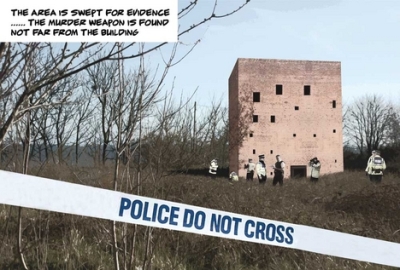
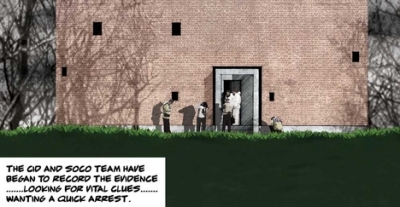
Despite some initial difficulties getting to London Waterloo station on Saturday morning, I spent the weekend in the Netherlands visiting the towns of Haarlem, Hilversum and Rotterdam. I was in Haarlem to meet the cartoonist Joost Swarte, and Rotterdam to meet the architect Henk Döll. The two men collaborated on the design of the Haarlem Toneelschuur Theatre which, as regular readers will recall, has become an interesting case study for this project. After our interview, Joost even took me for a stroll through the bustling streets of Haarlem to see the theatre, and also the neighbouring Johanes Enschede Hof social housing project, the design of which he was also involved in.
In Rotterdam on Monday morning, Henk Döll explained how he had been approached the design the theatre with Joost, and what engaging with a non-architect had meant for the creative process.
Both interviews were recorded, and I’m going to be up late most nights this week transcribing them for the project. Excerpts will appear here; the entirity of the texts may appear in a publication shortly, and the audio recording of my walk through Haarlem with Joost will be released as episode five of the ontheroad podcast later this week. Click here to subscribe via iTunes.
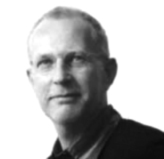
Further to the other recent announcements about forthcoming interviews, I’m very pleased to confirm that while in the Netherlands and in addition to meeting the cartoonist and illustrator Joost Swarte, I will be meeting the architect Henk Döll. Döll was the project architect at Mecanoo Architecten who worked with Swarte to build the Haarlem Toneelschuur. Döll now has his own practice in Rotterdam, who provide this useful biography.
Henk Döll (born 1956) graduated in 1984 from the Department of Architecture at the Technical University of Delft. As a result of winning and realising the ‘Kruisplein’ housing competition in Rotterdam (1980-1985), he was already working during his studies as an independent architect in the firm of Döll-Houben-Steenhuis. In 1983 this cooperative firm was changed into the Delft-based office of Mecanoo, in which he was partner until mid-2003. Within Mecanoo Henk Döll was responsible as leading architect for more than 120 projects and was also closely involved in many of the office’s other works. A large number of his projects, such as the Park Haagseweg residential area in Amsterdam, the Almelo Public Library, the multi-functional Rochussenstraat building in Rotterdam, and the Toneelschuur in Haarlem, are key projects in the history of Dutch architecture.
At Mecanoo he received various prizes and distinctions, such as the Rotterdam-Maaskant Prize for Young Architects in 1987, “for his innovative contribution to housing architecture”. His work has been shown at numerous exhibitions in the Netherlands and abroad and is often published in Dutch and international magazines and books.
Henk Döll regularly gives guest lectures and presentations and he teaches at various architectural schools, both at home and abroad. His appointments have included a guest professorship at the Institüt für Städtebau, Raumplanung und Raumordnung of the Technische Universität Wien (1995) and the Eliel Saarinen chair at the College of Architecture and Urban Planning of the University of Michigan (2000/2001). He has served on numerous competition juries and is currently a board member of the Genootschap Architectura et Amicitia and of the Atelier HSL Foundation.
Is a comic artist and illustrator without any formal architectural training necessarily a better or equally capable designer of buildings than a professional architect? By meeting both Joost Swarte (the comic artist) and Henk Döll (his partner in the Toneelschuur project), I look forward to finding out two very valuable opinions.
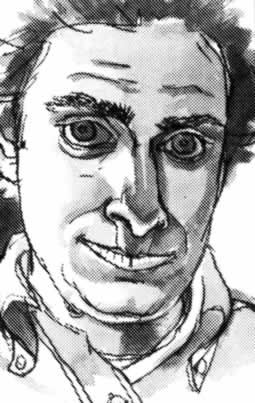
In addition to this week’s news that I will be travelling to the Netherlands in August to meet and talk with the comic artist and illustrator Joost Swarte, I can also now confirm that I will be in New York City in September to interview the artist Ben Katchor. This trip has also been supported by the Stephenson Travelling Studentship awarded to this project by the University of Sheffield. Katchor’s sophisticated evocation of nostalgia, memory in urban narratives are of particular personal interest to me, and I’m looking forward to discussing the techniques employed by Katchor in his popular serialised comics Julius Knipl Real Estate Photographer and The Jew of New York.
I’m also going to be celebrating a birthday in New York City, before perhaps taking off for a mini road trip and vacation in the mid-west, so excerpts and highlights of the interview will probably appear online in late September or early October.
If any interested readers are going to be in New York City between 11 and 16 September or Chicago between 17 and 27 September, drop me a line, and I’d be delighted to say hello.

